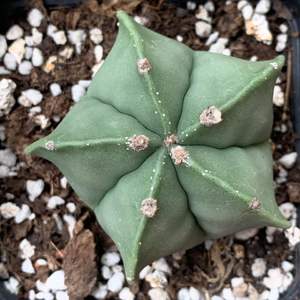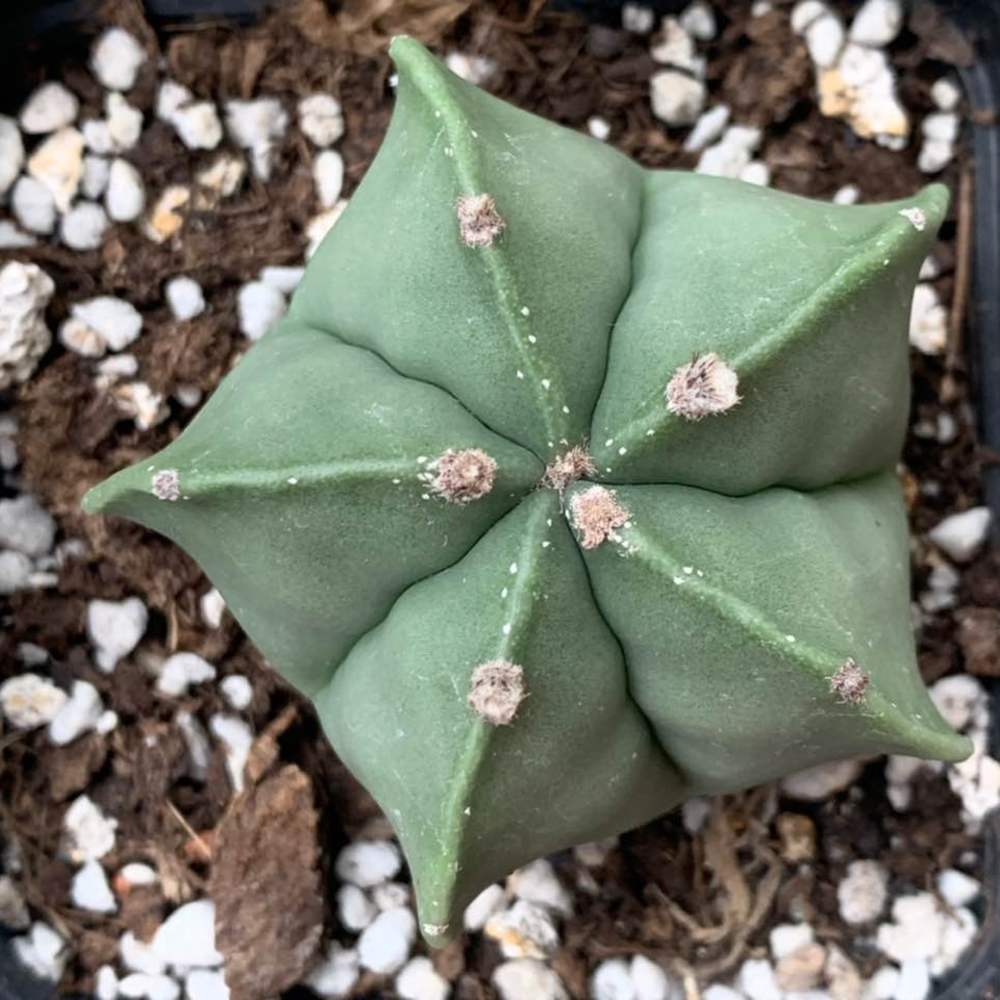植物经验
详细说明
Astrophytum myriostigma var. nudum is a spineless, usually solitary cactus. It is very similar to Astrophytum myriostigma, but lacks the white flecks on its stem and its epidermis is smooth. The stem is spherical to shortly columnar with age, up to 3.3 feet (1 m) tall and up to 4 inches (10 cm) in diameter. The number of ribs vary from 3 to 8 (usually 5). The flowers are pale-yellow, up to 2 inches (5 cm) long and appear in spring or early summer. It take up to 6 years to bloom.
How to Grow and Care
Bishop's Cap is one of the easiest Astrophytums to grow. It is sometime seen as a grafted plant but grows very well on its own roots too. Like other star cacti, it does not ask for much water and thrives even with a very small, Spartan root zone. They demand fast drainage overall and are downright hard to kill except with excessive moisture and rich soils. Very slow growth and small size is what makes them ideal for bonsai pots and other creative containers on porch, window sill or balcony. This is an ideal choice for beginners due to its lack of thorns, exceptional geometry and ease of cultivation indoors.
Bishop's Cap is cold hardy to about 20 °F (−6.7 °C). For best results it should be given light shade, although it will tolerate full sun. During the summer it should be given moderate water, but it should be kept dry as soon as the temperature starts dropping and keep it perfectly dry in winter at temperatures from 40 to 60 °F (5 to 15 °C). Bishop's Cap grows much faster with a low nitrogen content fertilizer in spring and summer.
Astrophytum myriostigma, commonly known as Bishop's Cap, is probably the most popular species of Astrophytum. It is an ideal windowsill cactus because it is thankfully spineless or nearly so. This tiny, rock hard gem of a plant does not demand high intensity light and will thrive in any south facing exposure as a house plant. It is native to the Chihuahuan Desert of central Mexico, but has been in cultivation so long there are numerous horticultural varieties. What makes it so unique is that each plant is a perfect five pointed star divided into as many identical segments. Bishop's Cap protects itself with a dense layer of fine chalky scales that give it a silvery gray color overall. Handle this cactus with care since the fragile scales can be easily rubbed off and will not grow back.
Bishop's Cap is a spring blooming species. At the center of the plant buds form at the tubercles that line the ridge that bisects each segment. These open into numerous vivid yellow flowers, each the size of a quarter. They are long lasting, drop off cleanly and rarely form seed capsules. Collectors of Astrophytum often seek out individuals with just four or six sections, which is not uncommon, giving these unique forms a higher commercial value.
How to Grow and Care
Bishop's Cap is one of the easiest Astrophytums to grow. It is sometime seen as a grafted plant but grows very well on its own roots too. Like other star cacti, it does not ask for much water and thrives even with a very small, Spartan root zone. They demand fast drainage overall and are downright hard to kill except with excessive moisture and rich soils. Very slow growth and small size is what makes them ideal for bonsai pots and other creative containers on porch, window sill or balcony. This is an ideal choice for beginners due to its lack of thorns, exceptional geometry and ease of cultivation indoors.
Bishop's Cap is cold hardy to about 20 °F (−6.7 °C). For best results it should be given light shade, although it will tolerate full sun. During the summer it should be given moderate water, but it should be kept dry as soon as the temperature starts dropping and keep it perfectly dry in winter at temperatures from 40 to 60 °F (5 to 15 °C). Bishop's Cap grows much faster with a low nitrogen content fertilizer in spring and summer.
Astrophytum myriostigma, commonly known as Bishop's Cap, is probably the most popular species of Astrophytum. It is an ideal windowsill cactus because it is thankfully spineless or nearly so. This tiny, rock hard gem of a plant does not demand high intensity light and will thrive in any south facing exposure as a house plant. It is native to the Chihuahuan Desert of central Mexico, but has been in cultivation so long there are numerous horticultural varieties. What makes it so unique is that each plant is a perfect five pointed star divided into as many identical segments. Bishop's Cap protects itself with a dense layer of fine chalky scales that give it a silvery gray color overall. Handle this cactus with care since the fragile scales can be easily rubbed off and will not grow back.
Bishop's Cap is a spring blooming species. At the center of the plant buds form at the tubercles that line the ridge that bisects each segment. These open into numerous vivid yellow flowers, each the size of a quarter. They are long lasting, drop off cleanly and rarely form seed capsules. Collectors of Astrophytum often seek out individuals with just four or six sections, which is not uncommon, giving these unique forms a higher commercial value.
花相册 (5)





kensong
2019年09月14日

This is my first growing diary. From AugustFame RM9















